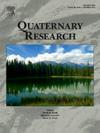Holocene millennial-scale variability of coastal environments on the southern coast of Korea and its controlling factors
IF 1.8
3区 地球科学
Q3 GEOGRAPHY, PHYSICAL
引用次数: 0
Abstract
Abstract Coastal evolution is influenced by past sea-level changes and resultant shifts from fluvial- to marine-dominant environments and the accompanying significant geochemical and isotopic changes in the water mass and sediments. We investigated the elemental and isotopic features of coastal sedimentary cores (27 m in length) from a small paleo-bay located on the southern coast of Korea to determine such geochemical variability and specify past changes in the bay environment and anoxic conditions and possible links to past climate changes. We analyzed total organic carbon (TOC), total sulfur (TS), their isotopes (δ 13 C TOC and δ 34 S TS ), and pyrite. The δ 13 C TOC values ranging from −25 to −19‰ (a proxy for terrestrial influence) were lower than average (−22.5‰) before 8300 cal yr BP and since 500 cal yr BP, while the intervening Early to Late Holocene showed higher δ 13 C TOC values, indicating a shallow coastal environment. The δ 34 S TS values fluctuating between −35 and +5‰ resembled sedimentation rate change. Based on the changes in the ratios of TOC to TS (C/S ratios), sedimentation rate, and δ 34 S TS , we found five possible periods with higher salinity and intensified anoxic conditions at millennial timescales: 8900–8200, 7950–6500, 5200–4300, 3500–2600, and 2000–1100 cal yr BP. These intensified anoxic conditions seem to have been influenced by increased air temperature and sea-surface temperature conditions, which could have intensified the intensity of thermal stratification (less ventilation and mixing) between surface and bottom waters and resultant anoxic conditions.朝鲜南部海岸环境的全新世千年尺度变率及其控制因素
海岸带演化受过去海平面变化和由此产生的由河流主导环境向海洋主导环境转变以及伴随的水体和沉积物中显著的地球化学和同位素变化的影响。我们研究了位于韩国南部海岸的一个小型古海湾的海岸沉积岩心(长27米)的元素和同位素特征,以确定这种地球化学变异,并指定海湾环境和缺氧条件的过去变化以及与过去气候变化的可能联系。分析了总有机碳(TOC)、总硫(TS)及其同位素(δ 13 C TOC和δ 34 S TS)和黄铁矿。8300 calyr BP之前和500 calyr BP之后,δ 13c TOC值均低于平均值(- 22.5‰),δ 13c TOC值高于平均值(- 25‰~ - 19‰),表明该区为浅海环境。δ 34 S - TS值在−35 ~ +5‰之间波动,与沉积速率变化相似。根据TOC / TS (C/S)比值、沉积速率和δ 34 S TS的变化,我们发现在千禧年时间尺度上,8900 ~ 8200、7950 ~ 6500、5200 ~ 4300、3500 ~ 2600和2000 ~ 1100 cal yr BP可能存在较高盐度和强化缺氧条件的5个时期。这些加剧的缺氧条件似乎受到气温和海面温度升高的影响,这可能加剧了表层和底层水之间的热分层强度(通风和混合减少)以及由此产生的缺氧条件。
本文章由计算机程序翻译,如有差异,请以英文原文为准。
求助全文
约1分钟内获得全文
求助全文
来源期刊

Quaternary Research
地学-地球科学综合
CiteScore
4.70
自引率
8.70%
发文量
57
审稿时长
3 months
期刊介绍:
Quaternary Research is an international journal devoted to the advancement of the interdisciplinary understanding of the Quaternary Period. We aim to publish articles of broad interest with relevance to more than one discipline, and that constitute a significant new contribution to Quaternary science. The journal’s scope is global, building on its nearly 50-year history in advancing the understanding of earth and human history through interdisciplinary study of the last 2.6 million years.
 求助内容:
求助内容: 应助结果提醒方式:
应助结果提醒方式:


